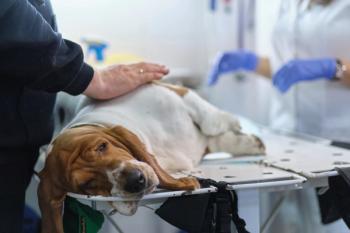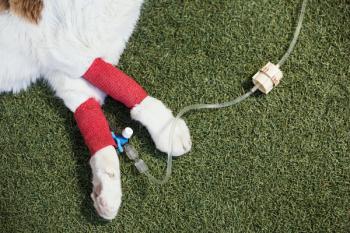
Pa. DVM pioneers stem cell treatment on neglect case
When police found him, Bernie had severe, third-degree burns on all four feet, and on his back and belly.
Wyomissing, Pa.
— Bernie was found on a rooftop of a row home in Reading, Pa., in the midst of a heat wave July 19. When police found him, the pit bull had severe, third-degree burns on all four feet, and on his back and belly, probably from falling or rolling over as his pads were scorched.
Photos courtesy of Dr. Boyd Wagner
Bernie's paws on July 24
To look at Bernie today, one would never guess his injuries were enough to warrant euthanasia. But a new stem cell treatment, which required special permission from the U.S. Food and Drug Administration (FDA), may have saved the dog's life.
"I would have thought that with such severe third-degree burns on these feet, you would have gotten a lot of scarring and deformity ... and it would have taken a lot longer than one month to heal," says Boyd Wagner, BVMS, MRCVS, and 25-year owner of the seven-veterinarian Wyomissing Animal Hospital, where Bernie was treated. "If you look at these feet now, there's beautiful epithelial tissue—like a baby's bottom."
Bernie's paws on Sept. 6.
Wagner, who has worked with the local Animal Rescue League for some time, first saw Bernie July 23, a few days after he was found on the rooftop. He treated him for a few weeks, released him back to the rescue group, and checks up on Bernie regularly. At a follow-up appointment Sept. 6, Wagner says Bernie is doing wonderfully. Normally, the Animal Rescue League may have opted to euthanize Bernie because his injuries were so severe. Treatment and the dog's care would have been complicated, time consuming and costly. His owners were never found. In the few days after Bernie's discovery, the dog was kept at the shelter on painkillers with his pads wrapped while animal-health authorities tried to locate and prosecute the owner.
When Wagner was approached to care for the dog, he had already been working with a California biotechnology company—owned by a Reading woman—for more than a year. Celavet has been using embryonic stem cells cultured at their labs for restorative treatments for horses for several years. Hoping to branch into companion-animal therapies, the company worked out a partnership with Wagner to perform case studies on a pro-bono basis. Wagner says he never advertised the service but offered it to select clients whose pets fit within the parameters of the case-study requirements. A benefit of the new method to veterinarians is that the lab-cultured stem cells don't have to be harvested from the patient, multiplied and shipped back to the veterinarian. He can request stem cells and receive them the next day, Wagner says. Celavet has FDA approval for the case studies at Wagner's clinic, but only for use in treating epilepsy and degenerative joint diseases. Wagner typically would use it for the latter, injecting stem cells into joints post-surgery. He does not experiment or make conclusions about stem cell use, but simply gives Celavet his subjective opinion on whether his patient healed any faster with the stem cell injections.
When he first met Bernie, Wagner thought the dog would be a great case to try stem cell therapy on, considering there was nothing to lose. So Celavet contacted FDA to try to obtain permission for the new use, explaining that this was a particularly compassionate case. With the FDA on board, Wagner got to work. On July 26, he filmed the treatment for FDA records and injected 1.5 million stem cells into each pad on Bernie's four feet.
"We had thought originally of just doing the front feet and not the back feet, but I said let's just try to help the dog and see what happens," Wagner says. "I have injected stem cells into enough joints that I know it's not going to hurt the dog.";
Bernie was placed under general anesthesia for the procedure, prior to which his feet were wrapped, and he was given antibiotics. The day after the injections, Wagner anesthetized Bernie again to check the progress. His pads were more irritated after the treatment, but Wagner says that is to be expected considering how many injections were done. Bernie's pads were rewrapped, and the dog's pain was appropriately managed, Wagner says.
Bernie, who is estimated to be 2 or 3 years old, is now back with the rescue league, which is trying to find him a new home, but Wagner checks his progress every Monday. As of Sept. 6, Wagner says his feet are 95 percent healed.
"When you see day one and four weeks later, you'd be very impressed. Was it the stem cells? I can't say that. But the dog feels better," Wagner says. "I can't believe how bad these were burned. And to see him four weeks later almost totally healed—I'm flabbergasted."
Since word of Bernie's treatment got out, Wagner says people have literally been coming off the street, asking him to offer stem cell treatments to their pets. But he doesn't want to get into the treatments as a business just yet, he says.
"If I had a dog I did surgery on for a stifle, I would inject it into that dog, no cost to the client," he says. Wagner continues the treatments for regular clients or interesting cases, but he is mostly turning people away who are requesting this treatment. "Ethically, I don't want to charge for experimental stuff," he says.
Newsletter
From exam room tips to practice management insights, get trusted veterinary news delivered straight to your inbox—subscribe to dvm360.





